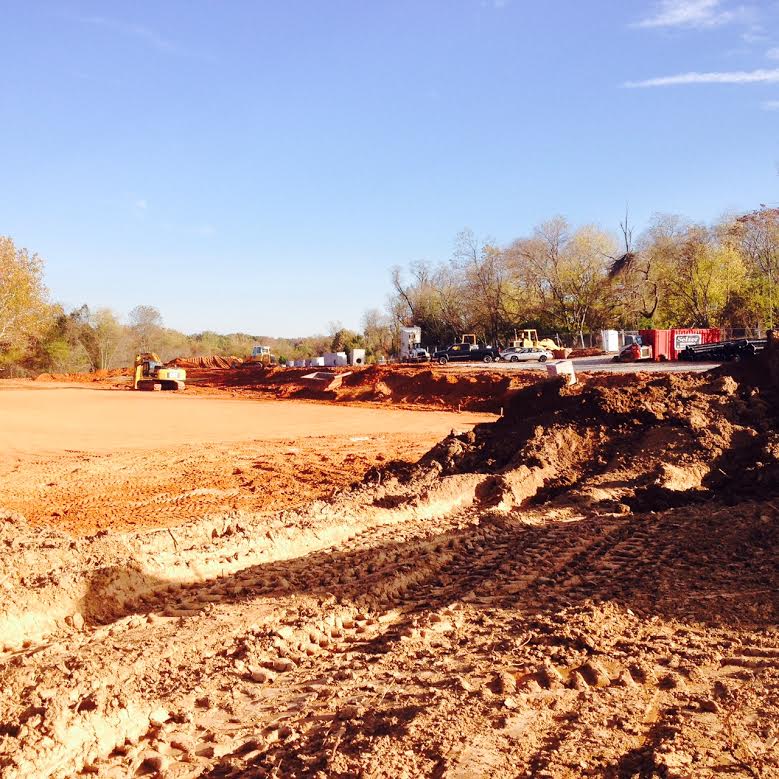Park brings Potomac watershed from surf to turf
The site for the interpretive playground is currently under construction in the Greenbriar Local Park and is expected to open in Fall 2015.
December 22, 2014
Children in the Potomac area will soon have a place where they can learn about their local environment in an interesting and interactive way with the opening of the area’s first interpretive playground.
An interpretative playground is one designed around a specific theme. The theme of this playground is the Potomac watershed and how water moves through it to the Chesapeake Bay. The playground will be part of Greenbriar Local Park which is scheduled to open in the Travilah area in Fall 2015.
“The idea for the concept came from the park itself,” project manager Linda Komes said. “A lovely stream meanders through the park property within a wooded stream valley. Over 15 acres of the 25 acre park will be preserved as existing forest; an additional two acres will be planted as open meadow areas.”
According to Komes, a 1998 Park, Recreation, and Open Space (PROS) Master Plan recognized that the area had high recreational needs that were not being met. The demand for the proposed facilities in Greenbriar Park was revalidated by the 2005 Land Preservation, Parks and Recreation Plan (LPPRP). The July 2012 PROS Plan reiterated again the shortage of large rectangular playing fields noted in the 2005 LPPRP, as well as identifying a lack of basketball courts in the Travilah planning area.
Greenbriar is classified as a local park and is intended to provide recreational facilities and open space for the wide-ranging community. The park will include the interpretive playground, a natural grass rectangular playing field, a basketball court, an extensive trail network, a 70-space parking lot and more.
The area for 5-to-12 year olds will include a play fort and tower including slides, a zip line and a tire swing, intended to resemble the Piedmont plateau. This is a region which takes up one fourth of Maryland’s total area and is bordered west by Blue Ridge Mountains and east by the Fall Line.
While there are many specific features aimed at younger children, the park will have something for everyone.
“I would anticipate that teens will love and will benefit from all of the new facilities, particularly the volleyball and basketball courts, the large playing field and the trails,” Komes said. “The seating areas will provide lots of great spots to just chill out.”
This playground is also intended to teach the community about Potomac’s natural environment. Interpretive and educational signage will describe water movement through the Potomac watershed. The signage is intended to describe the important role each person in the community plays in protecting our natural resources.
According to AP Environmental Science teacher Gary Rogers, learning about ecology in an outdoor setting is a great way to connect students to science content learned in school.
“An interpretative playground that connects the young learners to the scientific principles of nature will go a long way towards sparking their desire to learn and become good stewards of our environment,” Rogers said.
Some CHS students find the playground intriguing because it is an opportunity to learn about their local environment on their own time.
“This way we can voluntarily learn about the environment in a fun way,” senior Aaron Nadler said.
Other students see this playground as a great way to educate younger children about their impact on the environment.
“It’s smart to introduce the watershed to the younger age, because they will be able to know how to prevent it from being more damaged,” senior Alan Ha said. “Almost all of the watershed’s pollution comes from us so if more people are aware of what we are putting down our drains then we can stop pollution one at a time.”
According to Komes, the nature theme is evident throughout the entire park as many features in the park are made from local natural resources.
“Fieldstone walls and boulders will be located as seating elements and focal points contributing to a strong sense of place,” Komes said. “All of the new plant material is being grown in the Park Department’s Pope Farm Nursery and is predominantly native to the region.”


